
|
|
|
 |
Krishna Devaraya, 1509-1529 |
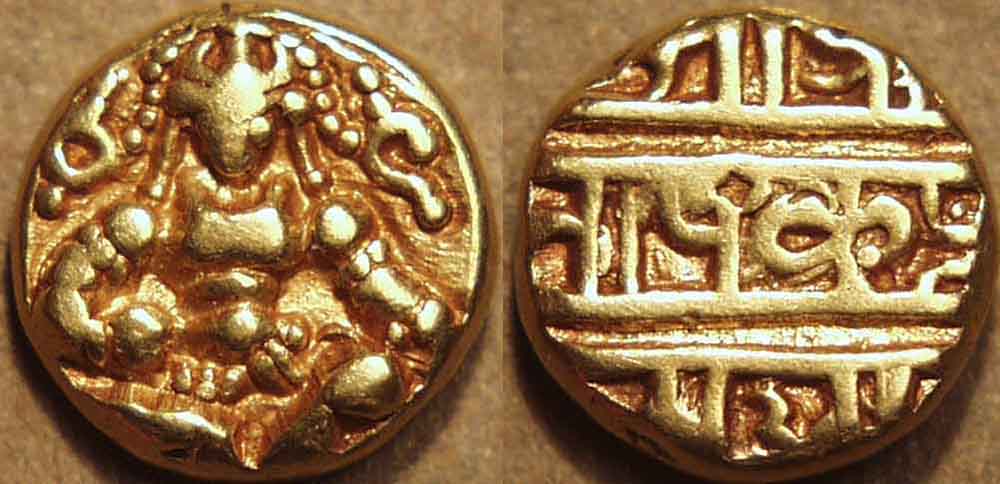
|
Krishna Devaraya Gold pagoda or gadyana
Weight: 3.32 gm. Diameter: 11 mm Die axis: 1 o'clock
Balakrishna seated facing, right leg tucked under and left leg hanging down,
flanked by chakra (discus) and sankh (conch)
Three-line Devanagari legend: sri pra / ta pa kri shna / ra ya
Reference: MNI 898, MSI 640
|
 |
After the death of Deva Raya II, the Vijayanagar empire went into a period of decline as infighting within the ruling dynasty and challenges
from the feudal lords sapped the resources of the kingdom. Eventually, the general Tuluva Narasa seized power and restored order. Krishna Devaraya was Tuluva Narasa's son
and he raised the empire to its greatest height, expanding north at the expense of the Sultanates, east into Kalinga and south into the peninsula.
|

|
Krishna Devaraya Gold 1/2 pagoda
Weight: 1.70 gm. Diameter: 10-11 mm Die axis: 12 o'clock
Balakrishna seated cross-legged facing, flanked by chakra (discus) and sankh (conch)
Three-line Devanagari legend: sri pra / ta pa kri shna / ra ya
Reference: MNI 899-900, MSI 641-644
|
 |
The half pagodas of Krishna Devaraya are much rarer than the full pagodas. Notice the unusual form of the letter ka.
|
 |
 |
 |
Achyutaraya, 1530-1542 |
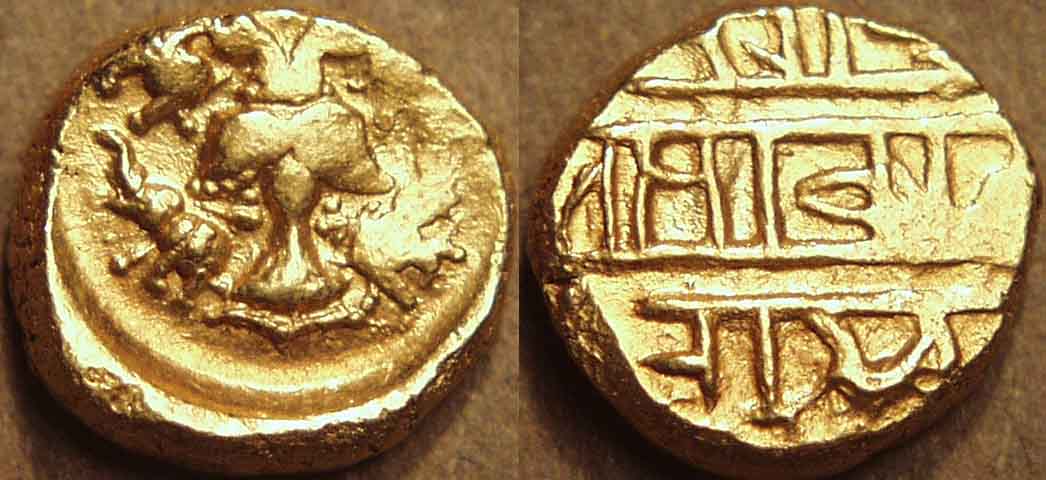
|
Achyutaraya Gold pagoda or gadyana
Weight: 3.37 gm. Diameter: 11-12 mm Die axis: 7 o'clock
Gandaberunda (double-headed eagle) standing facing, holding an elephant in each beak and in each foot
Three-line Devanagari legend: sri pra / ta pa chyu ta / ra ya
Reference: MNI 908, MSI 671
|
 |
Achyutaraya was the first king to put the mythical gandaberunda, or double-headed eagle, on his coins, even though the symbol
was quite ancient and had been used many times before on crests and seals. It is even today used on the emblem of Karnataka state and on many institutional crests in that state.
|
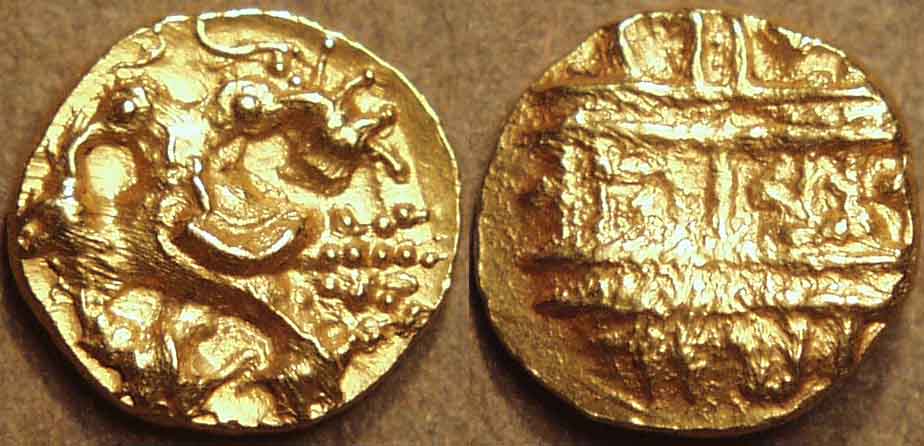
|
Achyutaraya Gold 1/2 pagoda
Weight: 1.69 gm. Diameter: 10-11 mm Die axis: 2 o'clock
Gandaberunda (double-headed eagle) walking left, holding an elephant in each beak and in each foot
Three-line Devanagari legend: sri pra / ta pa chyu ta / ra ya
Reference: MNI ---, MSI 673
|
 |
Here the gandaberunda is depicted walking to the left.
|
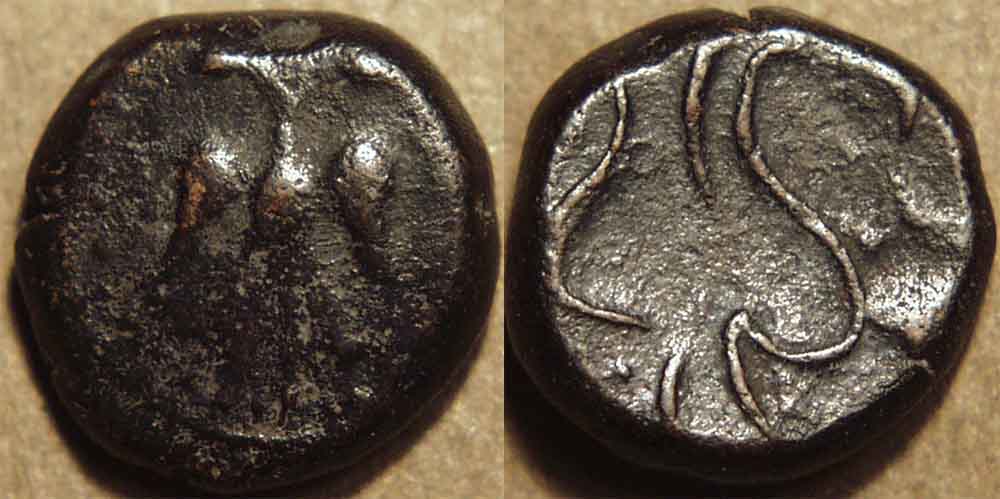
|
Achyutaraya AE kasu, Madurai
Weight: 3.26 gm. Diameter: 13 mm Die axis: 3 o'clock
Gandaberunda (double-headed eagle) displayed, holding a snake in each beak,
surrounded by a dotted and then a ruled circular border
Stylized trident or flower
Reference: MNI ---, MSI ---, Ganesh Coins of Tamilnadu, 13.48
|
 |
The attribution of this coin is tentative, although I feel fairly confident of it.
One expert I consulted suggested the reverse was the Kannada letter bu and therefore attributed the coin to Bukka Raya. However, the style of the coin does not agree with such
an early attribution. Ganesh, in his book, says these coins are found in Madurai and suggested that it might be an early issue of the Nayakas of Madurai. This is possible.
However, Ganesh also says that the Madurai Nayaka at the time, Viswanath Nayaka (1529-64) was a loyal feudatory of Vijayanagar. The Gandaberunda was the signature
symbol of Achyutaraya, and its presence on this coin therefore seems to pay homage to him. However, his name is not on the reverse. Thus the coin seems to be an issue of a loyal
feudatory who is getting ready to spread his wings, but hasn't quite done so yet. Unravelling the siginificance of the reverse might help in establishing whether the coin should be
seen as a Vijayanagar issue, or one of the earliest coins of the Nayakas of Madurai.
|
 |
 |
 |
Sadasivaraya, 1543-1570 |
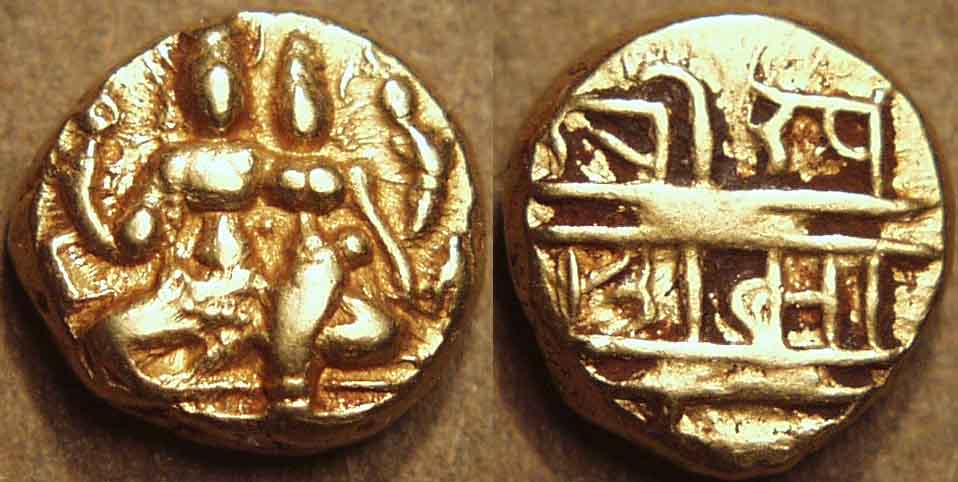
|
Sadasivaraya Gold pagoda or gadyana
Weight: 3.38 gm. Diameter: 11 mm Die axis: 9 o'clock
Vishnu and Lakshmi seated facing, Vishnu holding a chakra in each hand
Three-line Devanagari legend: sri sa / da si va ra / yalu
Reference: MNI 910 var
|
 |
Tirumalaraya, 1565-1578 |

|
Tirumalaraya Gold 1/2 pagoda
Weight: 1.69 gm. Diameter: 9 mm Die axis: 7 o'clock
Lord Rama seated cross-legged facing, flanked by Sita at right and Lakshmana at left (off flan)
Three-line Devanagari legend: sri ti / ru ma la ra / ya lu
Reference: MNI ---, MSI 805-806
|
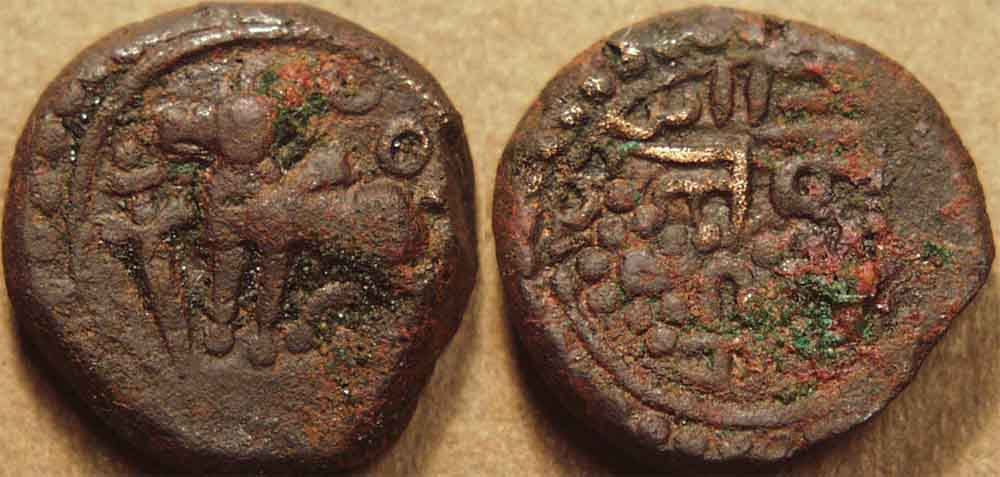
|
Tirumalaraya "Chalama" AE jital
Weight: 3.70 gm. Diameter: 15 mm Die axis: 4 o'clock
Humped bull standing left, facing dagger, sun and moon above
Two-line Nagari legend: cha la ma / ra ya, the two lines separated by a panel containing
a discus, crescent and conch
Reference: MNI ---, MSI 863
|
 |
Mitchiner assigns this coin to the Nayakas of Gingee, who were Vijayanagar feudatories and who issued coins in the name of the
Vijayanagar king.
|
 |
 |
 |
Venkata Raya III, 1632-1642 |

|
Venkataraya III Gold pagoda or gadyana
Weight: 3.32 gm. Diameter: 12 mm Die axis: 8 o'clock
Venkateswar (a form of Vishnu) standing facing holding chakra in each hand
Three-line Devanagari legend: sri venka / teswara / yanamah
Reference: MNI ---, MSI 834
|
 |
Venkata Raya III was the Vijayanagar king during whose reign the British received the land grant for land which became the city of
Madras. The earliest coins of the Madras Presidency were modeled on Vijayanagar coins.
|
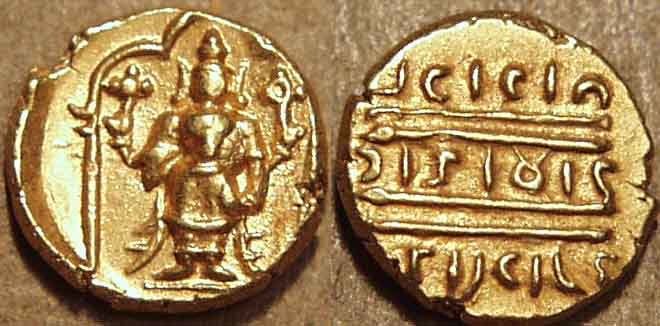
|
Venkataraya III Gold 1/2 pagoda
Weight: 1.71 gm. Diameter: 10 mm Die axis: 11 o'clock
Venkateswar (a form of Vishnu) standing facing, under arch, holding chakra and conch
Degenerate legend
Reference: MNI 920, MSI 835
|
Vijayanagar Feudatories
 |
Koneri Rayan, 1487-1512 |
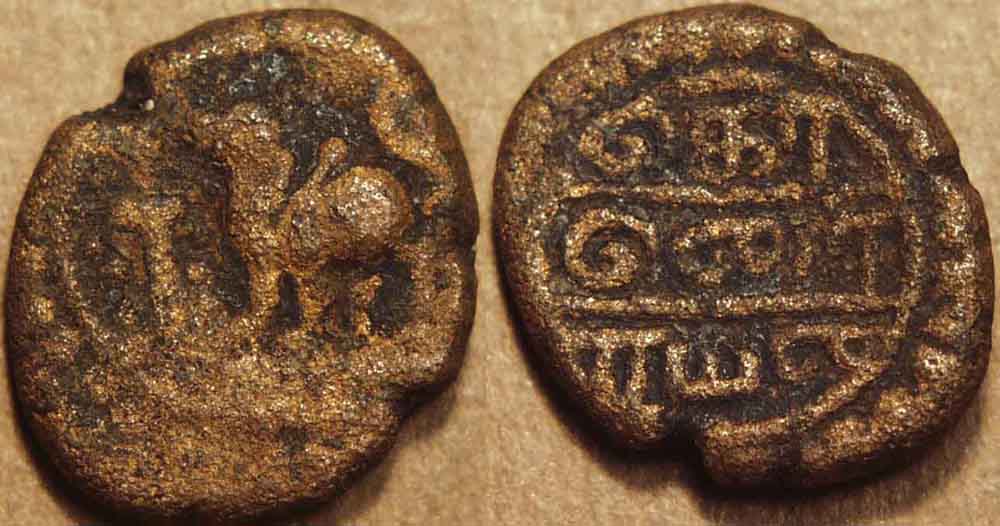
|
Koneri Rayan Copper jital
Weight: 3.29 gm. Diameter: 14-16 mm Die axis: 7 o'clock
Humped bull standing left, facing dagger, sun and moon above
Three-line Tamil legend: ko / ne ri / ra yan
Reference: MNI 1158, Ganesh Coins of Tamilnadu, 13.1
|
 |
Koneri Rayan was a Vijayanagar feudatory who ruled an area from Kanchipuram to Tiruchirappalli.
|
 |
 |
 |
Keladi Nayakas of Ikkeri, c. 1530-1763 |
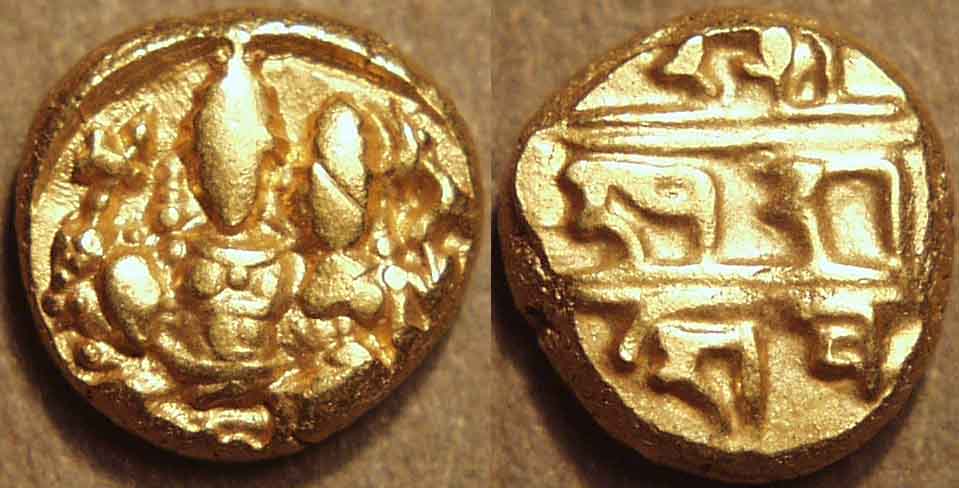
|
Gold pagoda or gadyana in the name of Sadasiva Nayaka (1530-1566)
Weight: 3.43 gm. Diameter: 10-11 mm Die axis: 5 o'clock
Siva and Parvati seated facing, Siva holding parasu (axe) and mriga (deer)
Three-line Devanagari legend: sri / sa da / si va
Reference: MNI 933, MSI 890
|
 |
The Keladi Nayakas of Ikkeri were feudatories of Vijayanagar, ruling in the eastern parts of Karnataka, who grew powerful enough to
issue their own coinage. It seems all of their coinage was issued in the name of the founder of the dynasty, Sadasiva Nayaka, and drew inspiration from the Uma-Maheswar coinage
of Hari Hara II. Their rule lasted for over 200 years. They were defeated by Haidar Ali and their kingdom was absorbed into the Kingdom of Mysore. Much of the gold for
Haidar Ali's coinage came from his plundering of the Ikkeri treasury and his coin type also clearly followed the design of
the Ikkeri pagodas.
|

|
Gold pagoda or gadyana in the name of Sadasiva Nayaka (1530-1566)
Weight: 3.44 gm. Diameter: 12 mm Die axis: 11 o'clock
Siva and Parvati seated facing, Siva holding parasu (axe) and mriga (deer)
Three-line Devanagari legend: sri / sa da / si va
Reference: MNI 933, MSI 890
|
 |
The Ikkeri pagodas vary in the way in which they treat Siva's torso..
|
 |
 |
 |
Nayakas of Chitradurga, c. mid-16th century-1779 |

|
Gold pagoda or gadyana in the name of Krishna Devaraya
Weight: 3.30 gm. Diameter: 13-14 mm Die axis: 7 o'clock
Balakrishna seated cross-legged facing
Three-line Devanagari legend: sri pra / ta pa kri shna / ra ya
Reference: MNI 939, MSI 882
|
 |
Timmana Nayaka was a general in the Vijayanagar army who received a grant of the Chitradurga area as a reward for his services. Over
time, the Nayakas of Chitradurga started to exercise their independence in the 16th century as Vijayanagar started to weaken. Their pagodas imitate the Balakrishna pagodas of
Krishna Devaraya. They were also eventually defeated by Haidar Ali and their kingdom absorbed by Mysore.
|
 |
 |
 |
Harathi Chiefs, c. 1621-1638 |
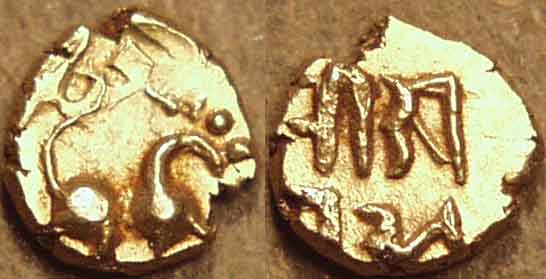
|
"Saraja" Gold fanam
Weight: 0.37 gm. Diameter: 6 mm Die axis: 9 o'clock
Lion standing right
Two-line Nagari legend: sri sa / ra ja
Reference: Ganesh and Girijapathy: Studies in South Indiain coins, Vol XII, pp.83-85
|
 |
The Harathi chiefs were feudatories of Vijayanagar, who received a grant from King Venkatapatiraya. They assumed the title "Saraja"
which is reflected on this coin.
|
|
|